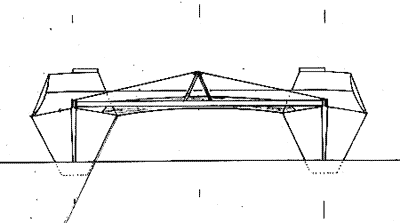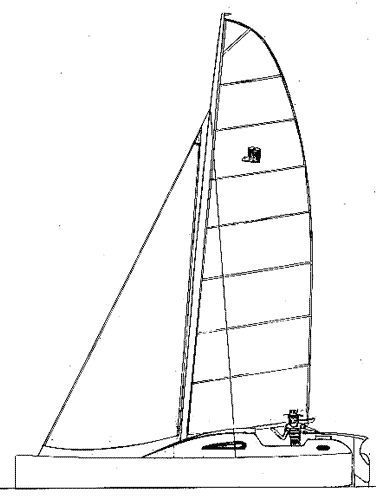Gumboots -In blue or hot water?
by Jeff Gilbert
I’m currently doing the final build plans
for Gumboots, a simplified 31foot dory derived catamaran. A
gentleman named Bob Sacher asked me about her offshore capability,
specifically in Alaska, the Horn and other inhospitable spots.
I was glad of the question, and here is the substance of the
reply:

Gumboots prime aim is simplicity (hence speed)
of build with the proviso that it must be UTTERLY SEAWORTHY.
Hence much of the design is based on the question:
What can & cant we do without? We cant do without a certain
amount of hard work in the way of:
I however reckon she can be built in 1200 hours.
That’s 4 months full time for two people. The main cost
is 78 sheets of quality marine ply.
Gumboots is a true offshore boat designed
for ocean travel at a good clip despite a good hammering, with
a reliable program producing predicted passage times are 220nm
per 24 hours in good 20knot winds.
In brief,
we dispense with the bridgedeck accommodation, and replace it
with low slung sail, so that the windage that blows you off
course is transferred to sail power and the waves that try to
topple you go thru the boat.
Gumboots deliberately sacrifices accomodation
space for offshore safety and seakeeping ability, but she is
however comfortable as long as you think in camping/minimalist
way and don’t take a crowd on passage. You can take 12
people day sailing, but I wouldn't cruise with more than 3 adults
or 2 adults/2 kids.
You can stand to cook, sit in a comfy armchair
and sleep in a comfy bed.
You can ablute without making the boat uninhabitable,
a massive attraction. Offshore boats with dunnies in the middle
are all wrong IMHO. People ARE sensitive, and are embarrassed.
On Gumboots you can even change tacks so that a sensitive crew
member can use the toilet opposite and behind your sailing position,
close the hatch and open
the port and there you go.
In detail, note the following:
-
Unlike most multis you sit in, not perched
on, the boat - the cockpits are deep and safe with a 4 foot
wall in front of you affording full visibility while protecting
the bulk of your body. Full dodgers are a possibility, but
I don’t like looking thru glass or plastic other than
sunglasses occasionally. . The cockpits are deep but still
self-draining, and directly steal potential internal space.
-
There are no companionways to fill the cabins
with water. You can talk to the cook thru an opening port
in the rear cabin wall.
-
The bridgedeck should be mostly slatted letting
storm waves thru the boat.
-
The centre of effort is low 20 ft ASL -the
raked mast and angled boom mean that the boom still clears
your head on the odd occasions you are not close hauled. You
can put nearly 40 horsepower into the boat thru the sails
before you have to reef at 27 knots wind speed, or at least
14kts boat speed.
-
The beam down the CL means you can rig her
any way you want. For single-handing you could rig her as
a schooner or ketch breaking up your sail area into small
chunks. Id also use double the standard 3 wire standing rig
- its only 3 lines - spectra rig her and double lines. Safety
plus.
-
For really heavy weather sailing one can
make provision for water ballast OR carry a lot of drinking
water, 200 gallons or so, filling up equally under berths
and cockpits for trim whilst retaining headroom areas. Loading
the boat to 3 tons wont worry her, it will just mean more
sail carrying power.
-
A powerful outboard fully protected in a
central box behind the rear beam will give you the ability
to outrun most weather patterns if you cant outsail them.
You could even make her a super motorsailor -use a Honda 90,
with a 13inch prop -this will cruise at 3600rpm & 46HP
at 2 imperial gallons per hour, the most economic outboard
ever (all the motor development of the Honda Civic car lies
in this engine) and send a fully loaded Gumboots along 17knots
or 8.5nm per imp gallon (6.7 US) with a top speed of 23knots.
Personally for serious cruising I'd look at
-
The Yanmar 27 diesel outboard - this
will give 10knots @ a US gallon per hour, or
-
a 4-stroke Honda 30 (cruise 10kts, max
14)
-
or direct injection 2 stroke which give
the same economy as the 4stroke without having to bother
with oil changes.
-
and carrying a spare 6HP in the head (they
now weigh 25kg and will give 6 knots on the main boat
while powering a riubber duck which can lash on half the
fore-tramp area.)
-
If you are taking heavy breaking beam seas,
you can raise the lee dagger a bit and sideslip instead of
flipping. The flat-bottomed touring cat Fallado survived a
beam hammering around the Horn in this manner. If you dont
have the searoom to lose this sort of leeway, start the motor
and make some.
-
Hove to against a sea anchor theres not much
for the sea to grab (see section)

I would hesitate to take any sailboat around Cape
Horn.
Discretion is the greater part of valour.
On the other hand I would not hesitate to sail
Gumboots anywhere. It is primarily designed for a gent who intends
taking with his wife around the Pacific.
Were I taking Gumboots to Alaska/ice areas Id
build her of 12mm ply instead of 9mm., and foam the first 3
feet or so to a crash bulkhead. The extra 400lbs wont worry
her and the gains in insulation would be worth
it.
In Gumboots I have attempted to retain the ease
of build and proven safeties of the Polynesian style, while
upgrading the accomodations to provide standing headroom to
cook and put your jeans on. Many good cats are butchered above
the sheerline in taking this too far. .
A navigation cuddy with a cockpit behind and full
length hull accoms was rejected equally because
- It raises the centre of effort of the sail plan 3 feet and
thus lessens sail carrying ability massively.
-
It raises build time.
-
It raises windage.
-
we have one in a rear cabin, and a toilet
in the other.
I hope 2004 is a good year for all.
Jeff Gilbert

|
|

